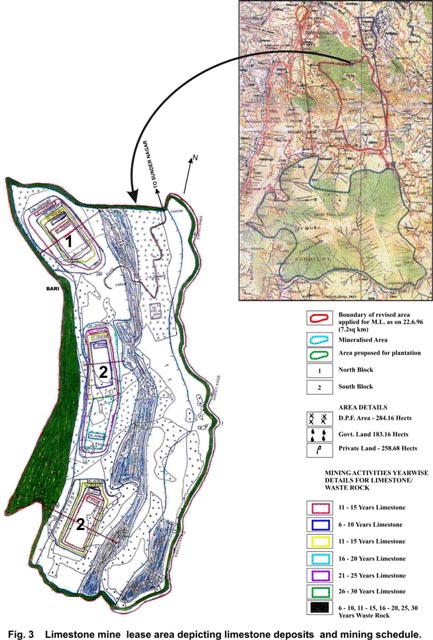Lime stone deposit character and estimated reserves
|
The limestone deposit belongs to Shali formations of Permian Age and is overlaid on Dolomatic Khatpul member of the same formation. It is well bedded, pink and grey in color with purple and grey shale partings. Soil cover is negligible. Joints and fractures are quite common, acting as channels for creating voids and cavities. Secondary calcinations have also been seen along voids and channels. In the mine lease area, three sets of the limestone deposits are identified. These are unequally distributed in two zones referred to as the north and the south blocks (Fig. 3).
In the northern block, limestone is folded and faulted. The deposit (numbered as 1 on Fig. 3) occurs in syncline form with one limb overturned. Two main synclines with axis in NW-SE direction are seen, both plunging and diverging in northern direction and coming nearest to each other on southern side at village Keran. On an average the strike of limestone is NW-SE to NNW-SSE with medium (20o) to steep (70o) dips on either side. Based on the geological investigations, the Geology Wing of the State Government provided an estimate of 103 million tonnes of limestone reserves in the north block, with limited mining depth up to 1200 m RL. A major portion of the north block deposit would not be mineable due to its narrow width, steep terrain proximity to the temple at the top and to the road from Maloh to Nalni. In the southern block (numbered as 2 in Fig. 3), rock formation suffered intense geotectonic movement resulting in more folding and faulting. Limestone usually occurs in synclinal troughs. Two main synclines with N-S to NW-SE axis have developed. In western limb, the width of limestone bed exposed is about 300 m over strike length of 800 – 900 m. Further north, width reduces to about 150 m. In this upper part strike length is about 1000 m. In the eastern belt, the limestone occurs in two detached synclinal troughs, each about 600 m along strike and 100 m in width. In south block, 55 million tonnes of limestone reserves have been estimated of which 49 million tonnes occur in the western belt and 6 million tonnes occur in eastern belt (Holtec Consulting Pvt. Ltd. 1996). The mineable reserves of the south block shall be able to sustain the raw material requirements of the cement plant for thirty years. The additional reserves would be subsequently exploited from the north block subsequently. |
Last Updated: October 5, 2015










